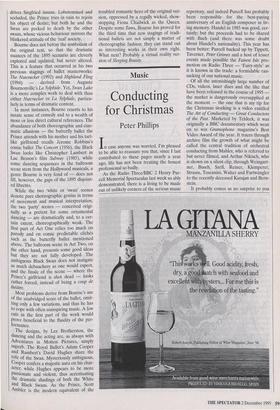Dance
Swan Lake (Sadler's Wells Theatre)
Barefoot in the Lake
Giannandrea Poesio
Erget the improbable fairytale, the bal- lerina who wears a feathery headdress and those cardboard birds that roll merrily against the backcloth. In Matthew Bourne's production of Swan Lake for Adventures in Motion Pictures, the action takes place in the Fifties, the swans are barefoot, bare- chested young men dressed in feathered trousers and members of the royal family behave in a far too familiar manner.
The 19th-century classic has been staged many times because its narrative offers such a wide range of interpretations: John Neumeier's radical rethinking of the ballet, Illusions: like Swan Lake (1976), and the 1986 contemporary adaptation by the Swedish choreographer Mats Ek are illus- trious precedents. In this Swan Lake, how- ever, Bourne has managed to dispel all thoughts of deja vu by creating a work which is definitely worth seeing. His Prince is a young monarch-to-be who suffers from the constraints of court life and who desperately longs for some free- dom, symbolised by the Swan, a bird-like male creature who has been haunting the Prince's dreams since childhood. Not unlike Odette, the enchanted Princess of the 1895 version, the Swan has a doppet- ganger; Bourne's equivalent of the Black Swan is a leather-clad rebellious youth who gatecrashes a formal royal ball and stirs up lustful thoughts in the guests. The Queen welcomes the youth's advances which drives Siegfried insane. Lobotomised and secluded, the Prince tries in vain to rejoin his object of desire; but both he and the Swan are pecked to death by the other swans, whose vicious behaviour mirrors the blinkered attitude of the 'real' society.
Bourne does not betray the symbolism of the original text, so that the dramatic nuances of the 1895 scenario are cleverly explored and updated, but never altered. This is a feature that occurred in his two previous stagings of ballet masterworks: The Nutcracker (1992) and Highland Fling (1994) — derived from Auguste Bournonville's La Sylphide. Yet, Swan Lake is a more complex work to deal with than either Nutcracker or La Sylphide, particu- larly in terms of dramatic content.
In most instances, Bourne resorts to his innate sense of comedy and to a wealth of more or less direct cultural references. The abundance of both choreographic and cine- matic allusions — the butterfly ballet the Prince attends with his mother and his tart- like girlfriend recalls Jerome Robbins's comic ballet The Concert (1956), the Black Swan looks like Christopher Lambert in Luc Besson's film Subway (1985), while some dancing sequences in the ballroom scene stem from the Hollywood musicals, a genre Bourne is very fond of — does not fill, however, the gaps of the 1895 disjoint- ed libretto.
While the two 'white or 'swan' scenes denote pure choreographic genius in terms of movement and musical interpretation, the two 'party' scenes — conceived origi- nally as a pretext for some ornamental dancing — are dramatically and, to a cer- tain extent, choreographically weak. The first part of Act One relies too much on parody and on comic predictable clichés such as the butterfly ballet mentioned above. The ballroom scene in Act Two, on the other hand, presents some good ideas but they are not fully developed. The ambiguous Black Swan does not instigate as much debauchery as one would expect, and the finale of the scene — where the Prince's girlfriend is shot dead — looks rather forced, instead of being a coup de theatre.
Most problems derive from Bourne's use of the unabridged score of the ballet, omit- ting only a few variations, and thus he has to cope with often uninspiring music. A few cuts in the first part of the work would prove beneficial to the fluidity of the per- formance.
The designs, by Lez Brotherston, the dancing and the acting are, as always with Adventures in Motion Pictures, simply superb. The Royal Ballet's Adam Cooper and Rambert's David Hughes share the role of the Swan. Mysteriously ambiguous, Cooper confers a majestic aura on his char- acter, while Hughes appears to be more passionate and violent, thus accentuating the dramatic shadings of both the White and Black Swans. As the Prince, Scott Ambler is the modern equivalent of the troubled romantic hero of the original ver- sion, oppressed by a regally wicked, show- stopping Fiona Chadwick as the Queen. Despite some flaws, Bourne has proved for the third time that new stagings of tradi- tional ballets are not simply a matter of choreographic fashion: they can stand out as interesting works in their own right. What next? Probably a virtual reality ver- sion of Sleeping Beauty.











































































 Previous page
Previous page